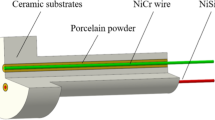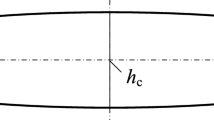Abstract
A scheme for online quality monitoring of resistance spot welding (RSW) process is proposed to effectively determine the rate of spot weld quality. In this work, the random forest (RF) classification featuring with dynamic resistance (DR) signals which were collected and processed in the production environment was carried out. The obtained results demonstrated that the constructed RF model based on DR profile features adequately distinguished high-quality welds from the other unacceptable welds such as inadequate sized welds and expulsions. Variable importance evaluation of RF was implemented against the input features. It showed that two DR slopes for nugget nucleation and growth (v 2 , v 3 ) and dynamic resistance (R γ ) in the final half cycle play the most significant roles in achieving more accurate results of classification, while absolute gradient ∇ max is useful in detecting minor expulsion from pull-out failure. In addition, shunting effect in consecutive welds was tentatively investigated via the DR curves, accounting for noticeable declines in the stage I of DR. The results revealed that shunted welds beyond minimum weld spacing do not significantly undermine the accuracy of classification. The implementation of RF based on the combination of welding parameters and DR features improves the accuracy of classification (98.8%) with ntree = 1000 and mtry = 4, as weld current significantly distinguished situations where DR features solely achieve accuracy (93.6%). The incorporation of the RF technique into online monitoring system attains a satisfying RSW quality classification accuracy and reduces the workload on destructive tests.
Similar content being viewed by others
References
Zhang H (1999) Expulsion and its influence on weld quality. WELD J-NEW YORK 78:373-s
Liu J, Xu G, Gu X, Zhou G (2015) Ultrasonic test of resistance spot welds based on wavelet package analysis. Ultrasonics 56:557–565
Wang H, Zhang Y, Chen G (2009) Resistance spot welding processing monitoring based on electrode displacement curve using moving range chart. Measurement 42:1032–1038
Gedeon S, Sorensen C, Ulrich K, Eagar T (1987) Measurement of dynamic electrical and mechanical properties of resistance spot welds. Weld J 66:378–385
Luo Y, Rui W, Xie X, Zhu Y (2016) Study on the nugget growth in single-phase AC resistance spot welding based on the calculation of dynamic resistance. J Mater Process Technol 229:492–500
Fan Q, Xu G, Gu X (2016) Expulsion characterization of stainless steel resistance spot welding based on dynamic resistance signal. J Mater Process Technol 236:235–240
Breiman L (2001) Random forests. Mach Learn 45:5–32
Martín Ó, Pereda M, Santos JI, Galán JM (2014) Assessment of resistance spot welding quality based on ultrasonic testing and tree-based techniques. J Mater Process Technol 214:2478–2487
Pereda M, Santos J, Martín Ó, Galán J (2015) Direct quality prediction in resistance spot welding process: sensitivity, specificity and predictive accuracy comparative analysis. Sci Technol Weld Join 20:679–685
Zhang P, Zhang H, Chen J, Ma Y (2007) Quality monitoring of resistance spot welding based on electrode displacement characteristics analysis. Front Mech Eng China 2:330–335
Wan X, Wang Y, Zhao D (2016) Quality monitoring based on dynamic resistance and principal component analysis in small scale resistance spot welding process. Int J Adv Manuf Tech 86(9–12):3443–3451
Zhang H, Wang F, Xi T, Zhao J, Wang L, Gao W (2015) A novel quality evaluation method for resistance spot welding based on the electrode displacement signal and the Chernoff faces technique. Mech Syst Signal Process 62:431–443
Wang B, Lou M, Shen Q, Li Y, Zhang H (2013) Shunting effect in resistance spot welding steels—part 1: experimental study. Weld J 92:182–189
AWS D17.2 (2007) Specification for Resistance Welding for Aerospace Applications
Long H, Hu Y, Jin X, Shao J, Zhu H (2016) Effect of holding time on microstructure and mechanical properties of resistance spot welds between low carbon steel and advanced high strength steel. Comput Mater Sci 117:556–563
Liaw A, Wiener M (2002) Classification and regression by randomForest. R news 2:18–22
Provost F, Domingos P (2000) Well-trained PETs: improving probability estimation trees. CeDER Working Paper #IS-00-04, Stern School of Business, New York University, NY 10012
Wen J, Wang C, Xu G, Zhang X (2009) Real time monitoring weld quality of resistance spot welding for stainless steel. ISIJ Int 49:553–556
Author information
Authors and Affiliations
Corresponding author
Ethics declarations
Funding
This study was funded by Australian Research Council (Grant No. LP130101001).
Conflict of interests
The authors declare that they have no competing interests.
Rights and permissions
About this article
Cite this article
Xing, B., Xiao, Y., Qin, Q.H. et al. Quality assessment of resistance spot welding process based on dynamic resistance signal and random forest based. Int J Adv Manuf Technol 94, 327–339 (2018). https://doi.org/10.1007/s00170-017-0889-6
Received:
Accepted:
Published:
Issue Date:
DOI: https://doi.org/10.1007/s00170-017-0889-6




